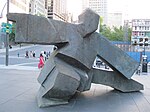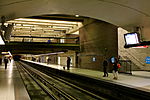Consulate General of Sweden, Montreal
The Consulate General of Sweden, Montreal was the diplomatic mission of Sweden in Montreal between 1916 and 1993. The consulate general originated from the consulate opened in 1906, which was converted into a consulate general in 1916. The consulate general tasks was to advance the interests of Sweden, and to serve and protect Swedes in Montreal and in different provinces and territories of Canada. Along with those in Chicago, Houston, Minneapolis, New York City, and San Francisco, the consulate general belonged to the so-called "heritage consulates" due to the large number of inheritance cases it handled. The consulate general's district comprised the whole of Canada until 1983. Between 1983 and 1991, divisions of the district occurred between the Swedish consulate general in Montreal, the consulate general in Toronto, and the consulate in Vancouver. From 1991 until its closure in 1993, the district consisted of Montreal and Quebec, New Brunswick, Newfoundland, Nova Scotia, and Prince Edward Island. The consulate general in Montreal closed in 1993, and since then, a Swedish honorary consulate has been operating in the city.
Excerpt from the Wikipedia article Consulate General of Sweden, Montreal (License: CC BY-SA 3.0, Authors).Consulate General of Sweden, Montreal
Boulevard Robert-Bourassa, Montreal Ville-Marie
Geographical coordinates (GPS) Address Website Nearby Places Show on map
Geographical coordinates (GPS)
| Latitude | Longitude |
|---|---|
| N 45.500175125 ° | E -73.561960324403 ° |
Address
Evo Montréal
Boulevard Robert-Bourassa 777
H3C 3Z7 Montreal, Ville-Marie
Quebec, Canada
Open on Google Maps







